Accounting Process Report: Australian Organizations and Standards
VerifiedAdded on 2022/08/31
|9
|1481
|19
Report
AI Summary
This report examines the accounting process within Australian organizations, both public and private, adhering to the Australian Accounting Standards Board (AASB) guidelines. It details the two tiers of AASB standards and their application, emphasizing the mandatory requirements for entities under the Corporations Act 2001 and government sectors. The report outlines the accounting process, from identifying transactions and recording journal entries to ledger posting, trial balance preparation, adjustments, financial statement preparation, closing entries, and post-closing trial balance. The report also covers the importance of accounting data recording, the double-entry system, and the stages involved in preparing financial statements. The report provides a comprehensive overview of the accounting process, essential for understanding financial reporting in Australia.
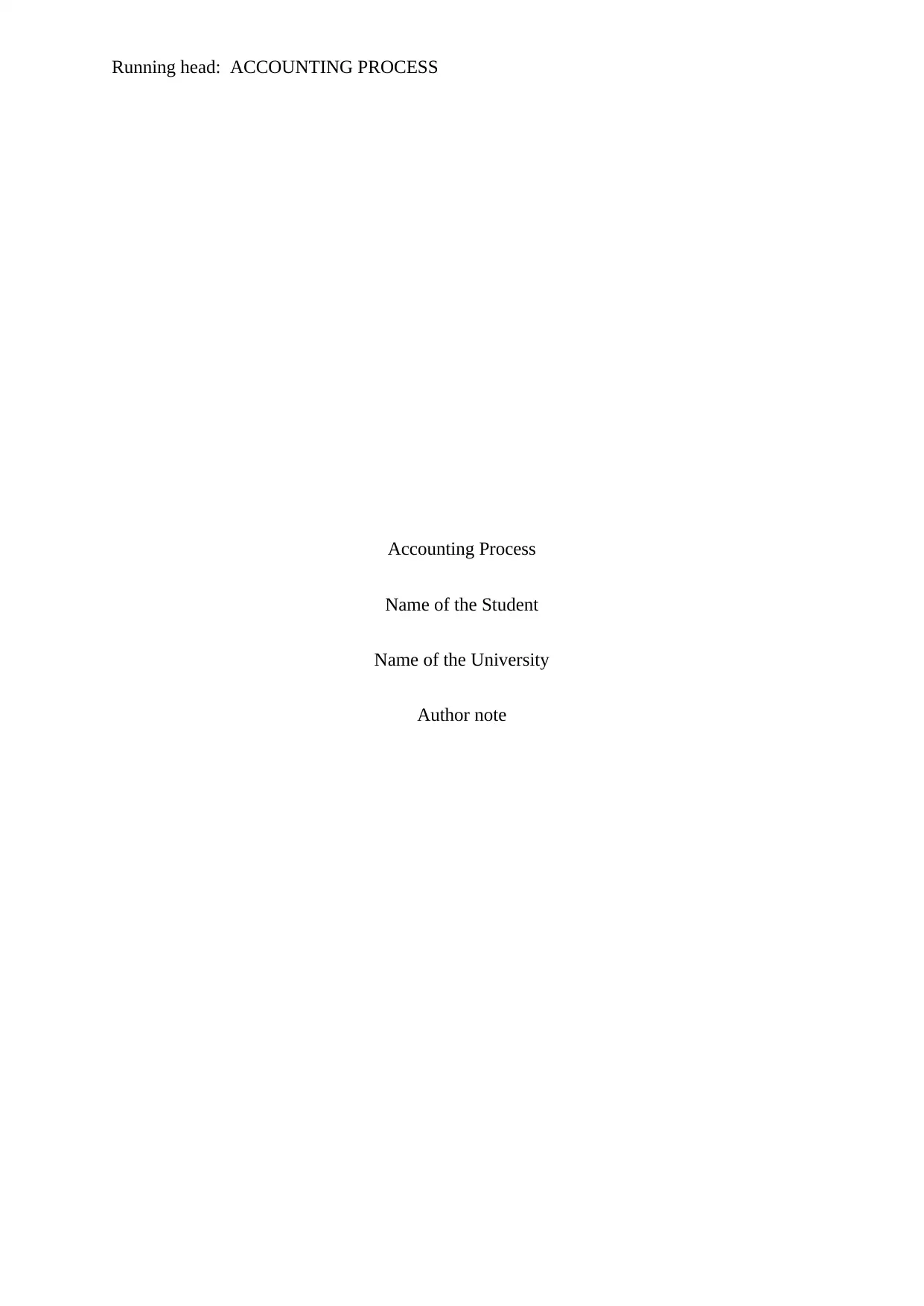
Running head: ACCOUNTING PROCESS
Accounting Process
Name of the Student
Name of the University
Author note
Accounting Process
Name of the Student
Name of the University
Author note
Paraphrase This Document
Need a fresh take? Get an instant paraphrase of this document with our AI Paraphraser
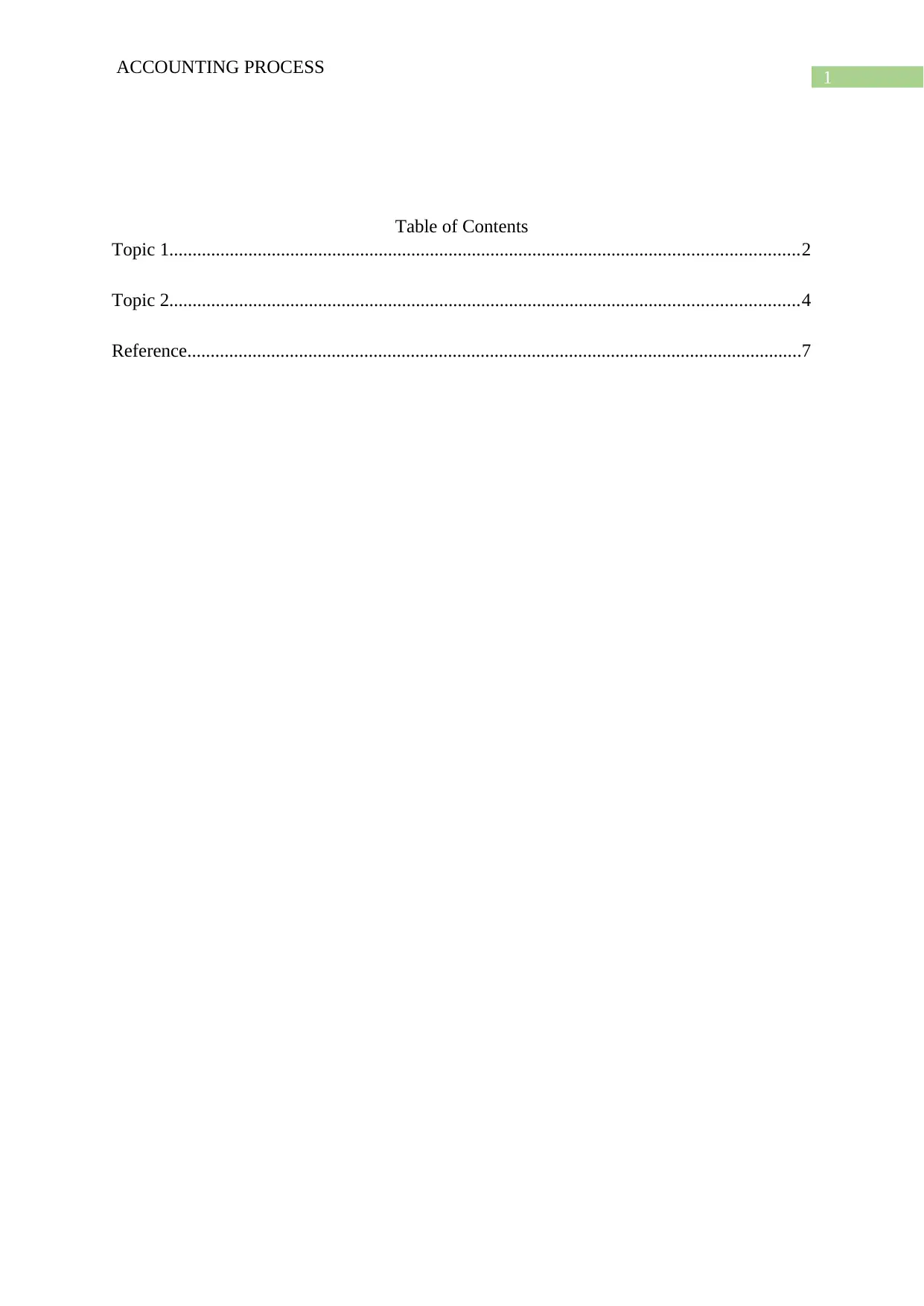
1
ACCOUNTING PROCESS
Table of Contents
Topic 1.......................................................................................................................................2
Topic 2.......................................................................................................................................4
Reference....................................................................................................................................7
ACCOUNTING PROCESS
Table of Contents
Topic 1.......................................................................................................................................2
Topic 2.......................................................................................................................................4
Reference....................................................................................................................................7

2
ACCOUNTING PROCESS
Topic 1
Organisations and accounting process
The accounting process of both the private and public organisations in Australia is
governed by the Australian accounting standard board. The AASB also sets the guidelines of
the global financial reporting standards which are followed by the Australian organisations in
setting global standards.
The accounting process prescribed by the AASB is mandatory for the following organisations
The entities required by the corporation act 2001 to prepare financial statements
government sectors that are required to prepare financial statements.
Both the public and private sectors for profit or not for profit that are reporting entities
or the entities that are required to make financial statement (Domingues et al 2017).
As per the AASB 1053 there are two tiers of Australian accounting standards which
clearly provides the accounting process that is to be followed by different organisations and
the requirements that are essential for the preparation of accounting standards.
Tier 1 Australian accounting standards
Tier 2 Australian accounting standards – reduced disclosure requirements
The tier 1 requirement is mandatory for profit making private sector that are publicly
accountable. The other profit-making private sector organisations which are not publicly
accountable should also comply with the requirements specified under the tier 1 of the AASB
(Artiach et al 2016).
ACCOUNTING PROCESS
Topic 1
Organisations and accounting process
The accounting process of both the private and public organisations in Australia is
governed by the Australian accounting standard board. The AASB also sets the guidelines of
the global financial reporting standards which are followed by the Australian organisations in
setting global standards.
The accounting process prescribed by the AASB is mandatory for the following organisations
The entities required by the corporation act 2001 to prepare financial statements
government sectors that are required to prepare financial statements.
Both the public and private sectors for profit or not for profit that are reporting entities
or the entities that are required to make financial statement (Domingues et al 2017).
As per the AASB 1053 there are two tiers of Australian accounting standards which
clearly provides the accounting process that is to be followed by different organisations and
the requirements that are essential for the preparation of accounting standards.
Tier 1 Australian accounting standards
Tier 2 Australian accounting standards – reduced disclosure requirements
The tier 1 requirement is mandatory for profit making private sector that are publicly
accountable. The other profit-making private sector organisations which are not publicly
accountable should also comply with the requirements specified under the tier 1 of the AASB
(Artiach et al 2016).
⊘ This is a preview!⊘
Do you want full access?
Subscribe today to unlock all pages.

Trusted by 1+ million students worldwide
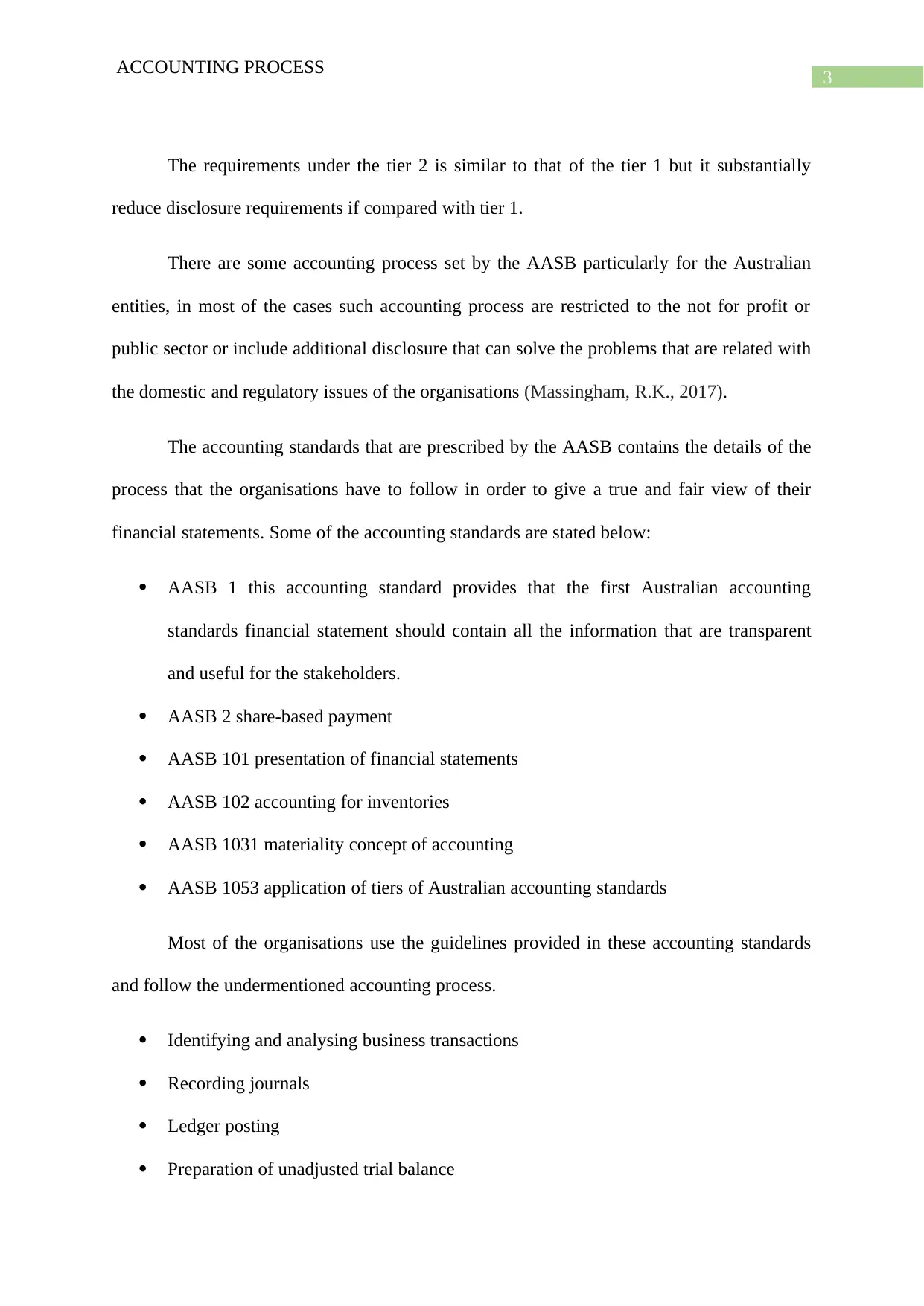
3
ACCOUNTING PROCESS
The requirements under the tier 2 is similar to that of the tier 1 but it substantially
reduce disclosure requirements if compared with tier 1.
There are some accounting process set by the AASB particularly for the Australian
entities, in most of the cases such accounting process are restricted to the not for profit or
public sector or include additional disclosure that can solve the problems that are related with
the domestic and regulatory issues of the organisations (Massingham, R.K., 2017).
The accounting standards that are prescribed by the AASB contains the details of the
process that the organisations have to follow in order to give a true and fair view of their
financial statements. Some of the accounting standards are stated below:
AASB 1 this accounting standard provides that the first Australian accounting
standards financial statement should contain all the information that are transparent
and useful for the stakeholders.
AASB 2 share-based payment
AASB 101 presentation of financial statements
AASB 102 accounting for inventories
AASB 1031 materiality concept of accounting
AASB 1053 application of tiers of Australian accounting standards
Most of the organisations use the guidelines provided in these accounting standards
and follow the undermentioned accounting process.
Identifying and analysing business transactions
Recording journals
Ledger posting
Preparation of unadjusted trial balance
ACCOUNTING PROCESS
The requirements under the tier 2 is similar to that of the tier 1 but it substantially
reduce disclosure requirements if compared with tier 1.
There are some accounting process set by the AASB particularly for the Australian
entities, in most of the cases such accounting process are restricted to the not for profit or
public sector or include additional disclosure that can solve the problems that are related with
the domestic and regulatory issues of the organisations (Massingham, R.K., 2017).
The accounting standards that are prescribed by the AASB contains the details of the
process that the organisations have to follow in order to give a true and fair view of their
financial statements. Some of the accounting standards are stated below:
AASB 1 this accounting standard provides that the first Australian accounting
standards financial statement should contain all the information that are transparent
and useful for the stakeholders.
AASB 2 share-based payment
AASB 101 presentation of financial statements
AASB 102 accounting for inventories
AASB 1031 materiality concept of accounting
AASB 1053 application of tiers of Australian accounting standards
Most of the organisations use the guidelines provided in these accounting standards
and follow the undermentioned accounting process.
Identifying and analysing business transactions
Recording journals
Ledger posting
Preparation of unadjusted trial balance
Paraphrase This Document
Need a fresh take? Get an instant paraphrase of this document with our AI Paraphraser

4
ACCOUNTING PROCESS
Posting of the entries that require adjustments
Then preparation of adjusted trial balance
From that prepare financial statement
Passing of closing entries
And finally, it is required to prepare post closing trial balance.
This is the basic accounting process which is maintained by both the private and
public organisations following the accounting standards applicable for each type of
transactions (Yusup Padeli and Ilamsyah 2017).
Topic 2
Recording accounting data
Accounting data is used to prepare a financial statement and to give a fair and true
picture of the financial condition of the company to the stakeholders. The recording of the
accounting data is essential for the proper documentation and to summarise all the financial
transactions in one place (Wells 2018).
For recording the accounting data, the organisations have to follow the accounting
process which is classified in to the following stages:
Identification of the accounting data
The first step of recording the accounting data is to identify and analyse the nature of
the data that is to be recorded in the books of accounts.
Journal posting
In the second step the accounting data has to be posted in the respective journals. The
accounting records are posted as per the double entry system. The accounting data contains
ACCOUNTING PROCESS
Posting of the entries that require adjustments
Then preparation of adjusted trial balance
From that prepare financial statement
Passing of closing entries
And finally, it is required to prepare post closing trial balance.
This is the basic accounting process which is maintained by both the private and
public organisations following the accounting standards applicable for each type of
transactions (Yusup Padeli and Ilamsyah 2017).
Topic 2
Recording accounting data
Accounting data is used to prepare a financial statement and to give a fair and true
picture of the financial condition of the company to the stakeholders. The recording of the
accounting data is essential for the proper documentation and to summarise all the financial
transactions in one place (Wells 2018).
For recording the accounting data, the organisations have to follow the accounting
process which is classified in to the following stages:
Identification of the accounting data
The first step of recording the accounting data is to identify and analyse the nature of
the data that is to be recorded in the books of accounts.
Journal posting
In the second step the accounting data has to be posted in the respective journals. The
accounting records are posted as per the double entry system. The accounting data contains

5
ACCOUNTING PROCESS
two accounts these are debit and credit. One transaction will be debited and another amount
will be credited (Trigo Belfo and Estébanez 2016).
Ledger posting
After posting the journals it will; be required to post ledgers. The ledgers show all the
changes that are made in a particular account and give the final balance which is to be
recorded in the trial balance.
Unadjusted trial balance
The trial balance is prepared to check that all the debit and credit balances are
recorded properly and if these are recorded accurately then both the side of the trial balance
will tally. The trial balance shows that all the accounting data are recorded under the proper
accounting head and that there is no error while recording the accounting data (Dooley 2018).
Adjustment entries
As most of the organisations follow accrual method of accounting so there will bew
some accounting data which will require adjustment at the time of closing the books of
accounts for a particular financial year.
The adjustment entries are posted to make the accounts updated before summarising
the financial statements.
Adjusted trial balance
After posting the adjustment entries it is required to post the accounting data from in
the adjusted trial balance for the preparation of the financial statements. From the adjusted
trial balance will give the information about the fact that all the debits are equal to all the
credits after posting the accounting entries for adjustment (Ghoorah 2017).
ACCOUNTING PROCESS
two accounts these are debit and credit. One transaction will be debited and another amount
will be credited (Trigo Belfo and Estébanez 2016).
Ledger posting
After posting the journals it will; be required to post ledgers. The ledgers show all the
changes that are made in a particular account and give the final balance which is to be
recorded in the trial balance.
Unadjusted trial balance
The trial balance is prepared to check that all the debit and credit balances are
recorded properly and if these are recorded accurately then both the side of the trial balance
will tally. The trial balance shows that all the accounting data are recorded under the proper
accounting head and that there is no error while recording the accounting data (Dooley 2018).
Adjustment entries
As most of the organisations follow accrual method of accounting so there will bew
some accounting data which will require adjustment at the time of closing the books of
accounts for a particular financial year.
The adjustment entries are posted to make the accounts updated before summarising
the financial statements.
Adjusted trial balance
After posting the adjustment entries it is required to post the accounting data from in
the adjusted trial balance for the preparation of the financial statements. From the adjusted
trial balance will give the information about the fact that all the debits are equal to all the
credits after posting the accounting entries for adjustment (Ghoorah 2017).
⊘ This is a preview!⊘
Do you want full access?
Subscribe today to unlock all pages.

Trusted by 1+ million students worldwide

6
ACCOUNTING PROCESS
Financial statement
The financial statements are prepared after it is ensured that all the data are posted
correctly and the balance of the debit side equally matched with the balance on the credit side
of the adjusted trial balance. The accounting data that is available from the adjusted trial
balance is then finally recorded in the financial statements that is in the income statements
and the balance sheet (Lv 2017).
Closing entries
The accounting data from the income statement are required to be closed to prepare
the statement of the next financial year. The temporary accounts that are to be closed are the
income, expenses and the drawings accounts.
Post closing trial balance
At the last stage the post closing trial balance is prepared. In this post closing trial
balance, all the nominal accounts are closed and the post closing balance contains the
balances of the real accounts only.
Reverse entries
Some accounting data may require to be posted by passing a reverse entry in the
books of accounts. The posting of the reverse entries is optional and these are posted at the
start of the new financial year to make the recording process smoother and more consistent.
ACCOUNTING PROCESS
Financial statement
The financial statements are prepared after it is ensured that all the data are posted
correctly and the balance of the debit side equally matched with the balance on the credit side
of the adjusted trial balance. The accounting data that is available from the adjusted trial
balance is then finally recorded in the financial statements that is in the income statements
and the balance sheet (Lv 2017).
Closing entries
The accounting data from the income statement are required to be closed to prepare
the statement of the next financial year. The temporary accounts that are to be closed are the
income, expenses and the drawings accounts.
Post closing trial balance
At the last stage the post closing trial balance is prepared. In this post closing trial
balance, all the nominal accounts are closed and the post closing balance contains the
balances of the real accounts only.
Reverse entries
Some accounting data may require to be posted by passing a reverse entry in the
books of accounts. The posting of the reverse entries is optional and these are posted at the
start of the new financial year to make the recording process smoother and more consistent.
Paraphrase This Document
Need a fresh take? Get an instant paraphrase of this document with our AI Paraphraser
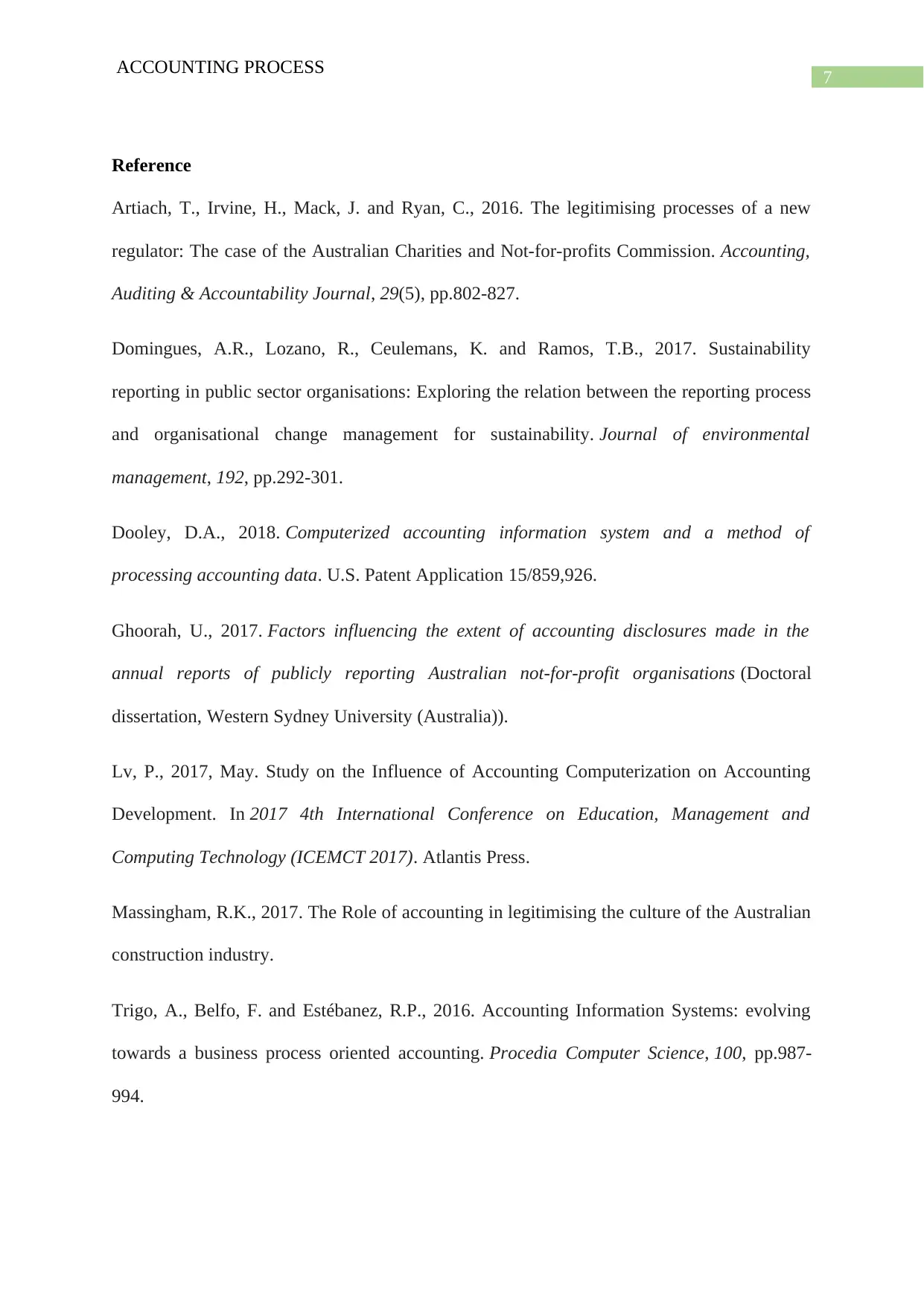
7
ACCOUNTING PROCESS
Reference
Artiach, T., Irvine, H., Mack, J. and Ryan, C., 2016. The legitimising processes of a new
regulator: The case of the Australian Charities and Not-for-profits Commission. Accounting,
Auditing & Accountability Journal, 29(5), pp.802-827.
Domingues, A.R., Lozano, R., Ceulemans, K. and Ramos, T.B., 2017. Sustainability
reporting in public sector organisations: Exploring the relation between the reporting process
and organisational change management for sustainability. Journal of environmental
management, 192, pp.292-301.
Dooley, D.A., 2018. Computerized accounting information system and a method of
processing accounting data. U.S. Patent Application 15/859,926.
Ghoorah, U., 2017. Factors influencing the extent of accounting disclosures made in the
annual reports of publicly reporting Australian not-for-profit organisations (Doctoral
dissertation, Western Sydney University (Australia)).
Lv, P., 2017, May. Study on the Influence of Accounting Computerization on Accounting
Development. In 2017 4th International Conference on Education, Management and
Computing Technology (ICEMCT 2017). Atlantis Press.
Massingham, R.K., 2017. The Role of accounting in legitimising the culture of the Australian
construction industry.
Trigo, A., Belfo, F. and Estébanez, R.P., 2016. Accounting Information Systems: evolving
towards a business process oriented accounting. Procedia Computer Science, 100, pp.987-
994.
ACCOUNTING PROCESS
Reference
Artiach, T., Irvine, H., Mack, J. and Ryan, C., 2016. The legitimising processes of a new
regulator: The case of the Australian Charities and Not-for-profits Commission. Accounting,
Auditing & Accountability Journal, 29(5), pp.802-827.
Domingues, A.R., Lozano, R., Ceulemans, K. and Ramos, T.B., 2017. Sustainability
reporting in public sector organisations: Exploring the relation between the reporting process
and organisational change management for sustainability. Journal of environmental
management, 192, pp.292-301.
Dooley, D.A., 2018. Computerized accounting information system and a method of
processing accounting data. U.S. Patent Application 15/859,926.
Ghoorah, U., 2017. Factors influencing the extent of accounting disclosures made in the
annual reports of publicly reporting Australian not-for-profit organisations (Doctoral
dissertation, Western Sydney University (Australia)).
Lv, P., 2017, May. Study on the Influence of Accounting Computerization on Accounting
Development. In 2017 4th International Conference on Education, Management and
Computing Technology (ICEMCT 2017). Atlantis Press.
Massingham, R.K., 2017. The Role of accounting in legitimising the culture of the Australian
construction industry.
Trigo, A., Belfo, F. and Estébanez, R.P., 2016. Accounting Information Systems: evolving
towards a business process oriented accounting. Procedia Computer Science, 100, pp.987-
994.
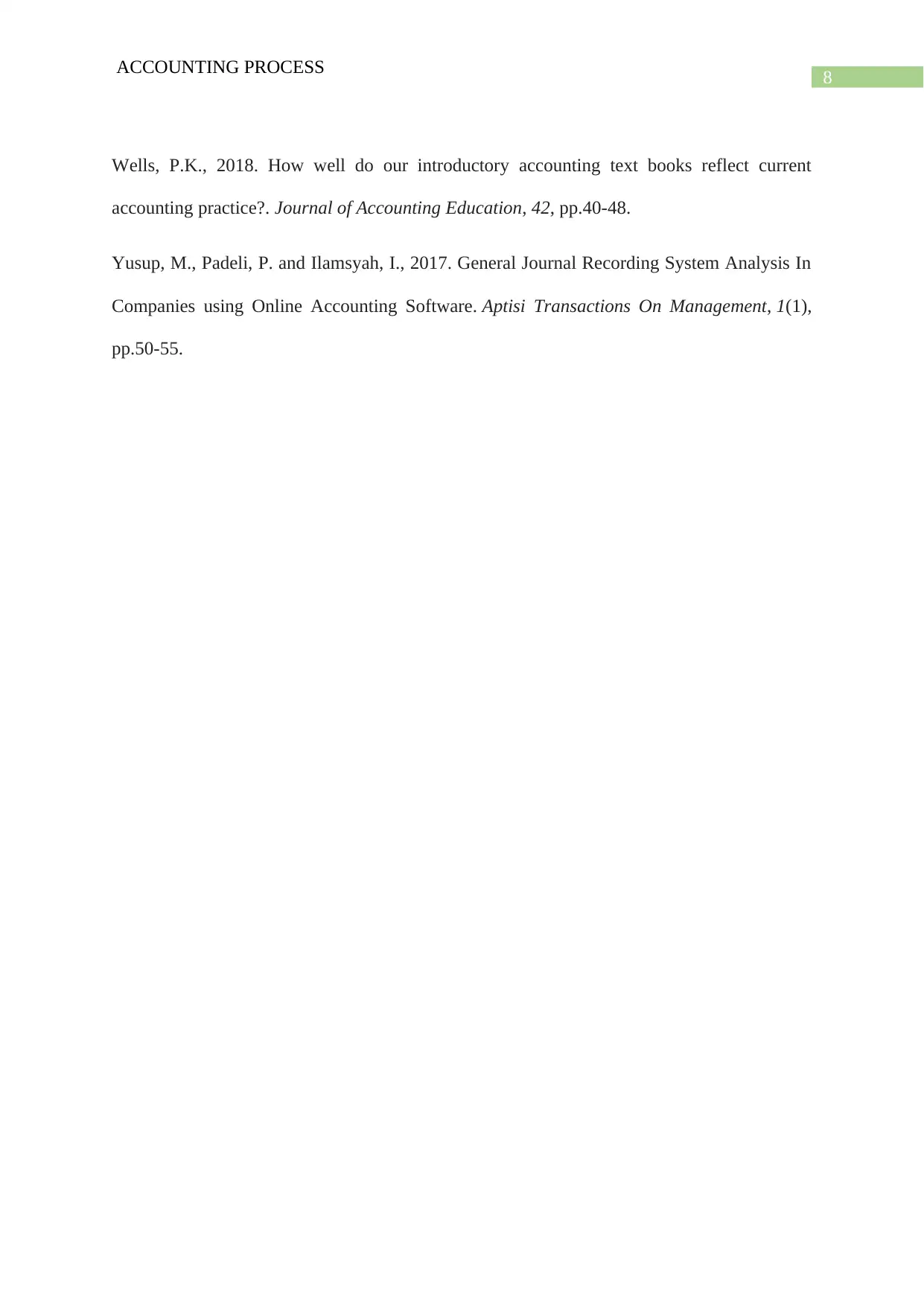
8
ACCOUNTING PROCESS
Wells, P.K., 2018. How well do our introductory accounting text books reflect current
accounting practice?. Journal of Accounting Education, 42, pp.40-48.
Yusup, M., Padeli, P. and Ilamsyah, I., 2017. General Journal Recording System Analysis In
Companies using Online Accounting Software. Aptisi Transactions On Management, 1(1),
pp.50-55.
ACCOUNTING PROCESS
Wells, P.K., 2018. How well do our introductory accounting text books reflect current
accounting practice?. Journal of Accounting Education, 42, pp.40-48.
Yusup, M., Padeli, P. and Ilamsyah, I., 2017. General Journal Recording System Analysis In
Companies using Online Accounting Software. Aptisi Transactions On Management, 1(1),
pp.50-55.
⊘ This is a preview!⊘
Do you want full access?
Subscribe today to unlock all pages.

Trusted by 1+ million students worldwide
1 out of 9
Related Documents
Your All-in-One AI-Powered Toolkit for Academic Success.
+13062052269
info@desklib.com
Available 24*7 on WhatsApp / Email
![[object Object]](/_next/static/media/star-bottom.7253800d.svg)
Unlock your academic potential
Copyright © 2020–2025 A2Z Services. All Rights Reserved. Developed and managed by ZUCOL.





